ignition CADILLAC XLR V 2007 1.G User Guide
[x] Cancel search | Manufacturer: CADILLAC, Model Year: 2007, Model line: XLR V, Model: CADILLAC XLR V 2007 1.GPages: 512, PDF Size: 3.84 MB
Page 139 of 512
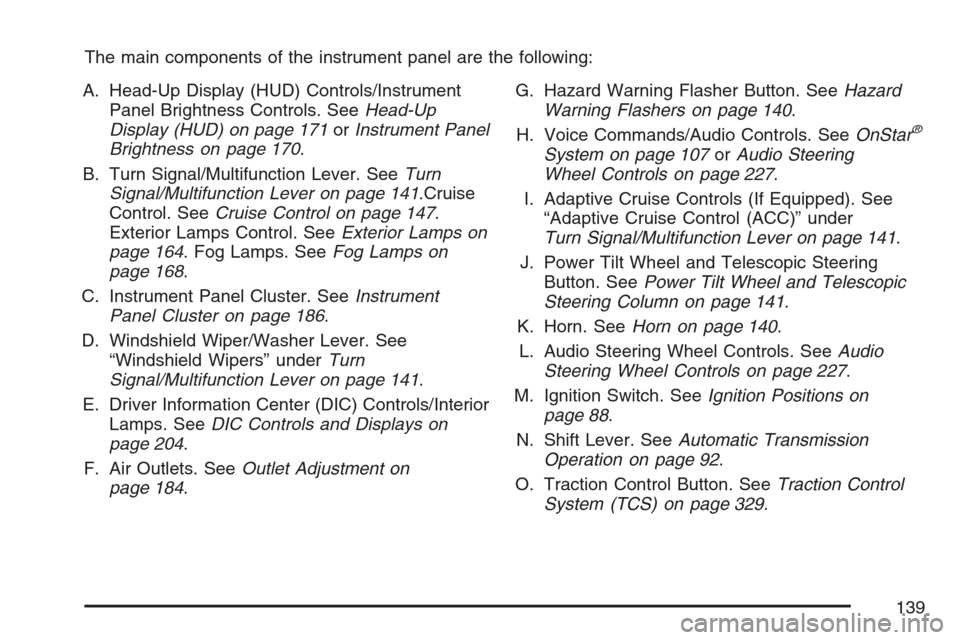
The main components of the instrument panel are the following:
A. Head-Up Display (HUD) Controls/Instrument
Panel Brightness Controls. SeeHead-Up
Display (HUD) on page 171orInstrument Panel
Brightness on page 170.
B. Turn Signal/Multifunction Lever. SeeTurn
Signal/Multifunction Lever on page 141.Cruise
Control. SeeCruise Control on page 147.
Exterior Lamps Control. SeeExterior Lamps on
page 164. Fog Lamps. SeeFog Lamps on
page 168.
C. Instrument Panel Cluster. SeeInstrument
Panel Cluster on page 186.
D. Windshield Wiper/Washer Lever. See
“Windshield Wipers” underTurn
Signal/Multifunction Lever on page 141.
E. Driver Information Center (DIC) Controls/Interior
Lamps. SeeDIC Controls and Displays on
page 204.
F. Air Outlets. SeeOutlet Adjustment on
page 184.G. Hazard Warning Flasher Button. SeeHazard
Warning Flashers on page 140.
H. Voice Commands/Audio Controls. SeeOnStar
®
System on page 107orAudio Steering
Wheel Controls on page 227.
I. Adaptive Cruise Controls (If Equipped). See
“Adaptive Cruise Control (ACC)” under
Turn Signal/Multifunction Lever on page 141.
J. Power Tilt Wheel and Telescopic Steering
Button. SeePower Tilt Wheel and Telescopic
Steering Column on page 141.
K. Horn. SeeHorn on page 140.
L. Audio Steering Wheel Controls. SeeAudio
Steering Wheel Controls on page 227.
M. Ignition Switch. SeeIgnition Positions on
page 88.
N. Shift Lever. SeeAutomatic Transmission
Operation on page 92.
O. Traction Control Button. SeeTraction Control
System (TCS) on page 329.
139
Page 140 of 512
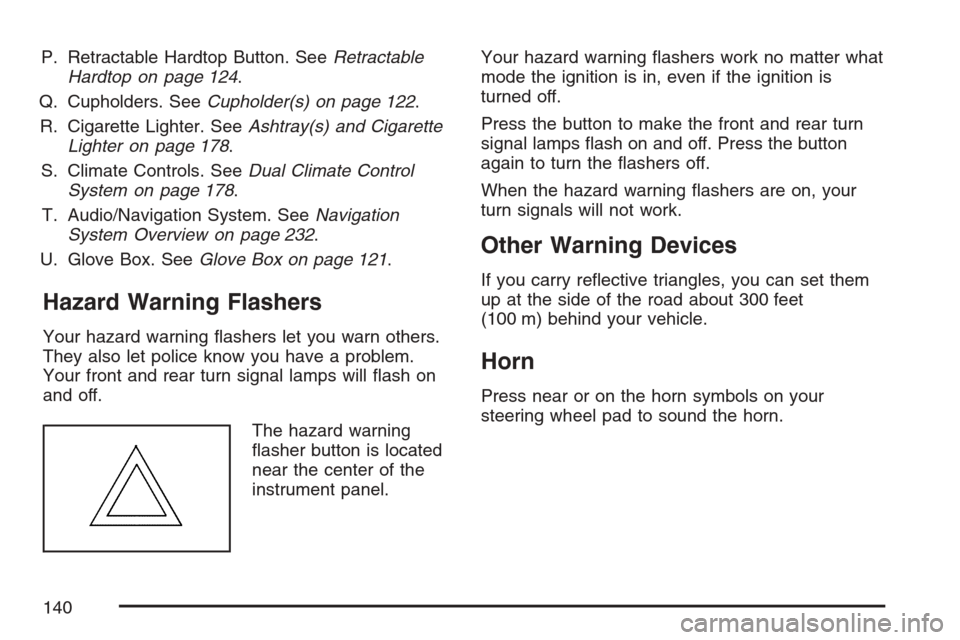
P. Retractable Hardtop Button. SeeRetractable
Hardtop on page 124.
Q. Cupholders. SeeCupholder(s) on page 122.
R. Cigarette Lighter. SeeAshtray(s) and Cigarette
Lighter on page 178.
S. Climate Controls. SeeDual Climate Control
System on page 178.
T. Audio/Navigation System. SeeNavigation
System Overview on page 232.
U. Glove Box. SeeGlove Box on page 121.
Hazard Warning Flashers
Your hazard warning �ashers let you warn others.
They also let police know you have a problem.
Your front and rear turn signal lamps will �ash on
and off.
The hazard warning
�asher button is located
near the center of the
instrument panel.Your hazard warning �ashers work no matter what
mode the ignition is in, even if the ignition is
turned off.
Press the button to make the front and rear turn
signal lamps �ash on and off. Press the button
again to turn the �ashers off.
When the hazard warning �ashers are on, your
turn signals will not work.
Other Warning Devices
If you carry re�ective triangles, you can set them
up at the side of the road about 300 feet
(100 m) behind your vehicle.
Horn
Press near or on the horn symbols on your
steering wheel pad to sound the horn.
140
Page 150 of 512

Using Cruise Control on Hills
How well your cruise control works on hills
depends upon your speed, load and the steepness
of the hills. When going up steep hills, you
might have to step on the accelerator pedal to
maintain your speed. When going downhill,
you might have to brake or shift to a lower gear to
keep your vehicle’s speed down. Of course,
applying the brake turns off the cruise control.
Many drivers �nd this to be too much trouble and
do not use cruise control on steep hills.
Ending Cruise Control
There are two ways to turn off the cruise control:
Step lightly on the brake pedal
Move the cruise control switch to off
Erasing Speed Memory
Turning off the cruise control or the ignition, will
erase your cruise control set speed memory.
Adaptive Cruise Control
If your vehicle has this feature, be sure to read
this entire section before using it.
The system operates on a radio frequency subject
to Federal Communications Commission (FCC)
Rules and with Industry Canada.
This device complies with Part 15 of the FCC
Rules. Operation is subject to the following
two conditions:
1. This device may not cause interference.
2. This device must accept any interference
received, including interference that may
cause undesired operation of the device.
This device complies with RSS-210 of Industry
Canada. Operation is subject to the following two
conditions:
1. This device may not cause interference.
2. This device must accept any interference
received, including interference that may
cause undesired operation of the device.
Changes or modi�cations to this system by other
than an authorized service facility could void
authorization to use this equipment.
150
Page 163 of 512
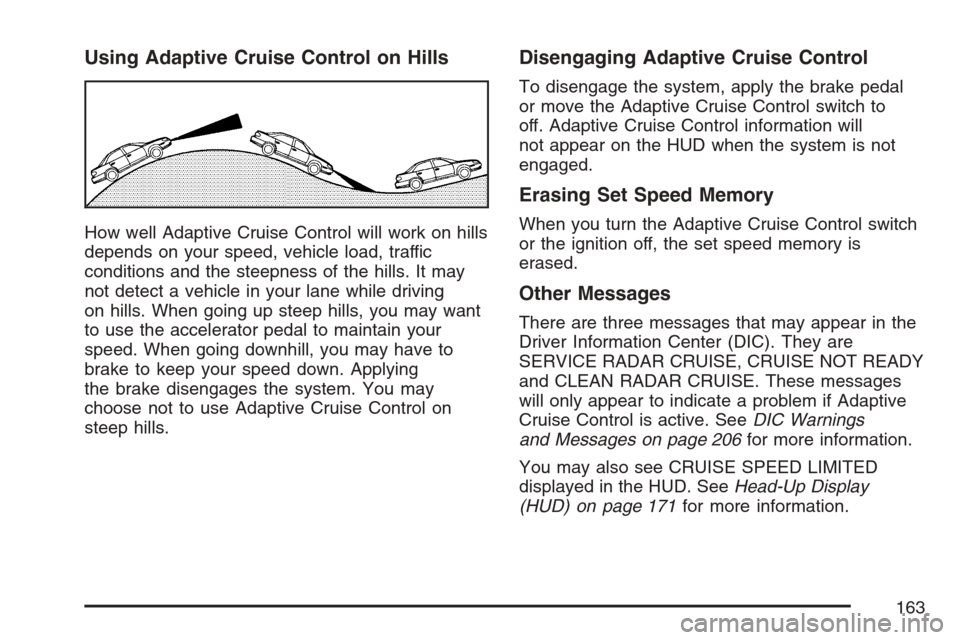
Using Adaptive Cruise Control on Hills
How well Adaptive Cruise Control will work on hills
depends on your speed, vehicle load, traffic
conditions and the steepness of the hills. It may
not detect a vehicle in your lane while driving
on hills. When going up steep hills, you may want
to use the accelerator pedal to maintain your
speed. When going downhill, you may have to
brake to keep your speed down. Applying
the brake disengages the system. You may
choose not to use Adaptive Cruise Control on
steep hills.
Disengaging Adaptive Cruise Control
To disengage the system, apply the brake pedal
or move the Adaptive Cruise Control switch to
off. Adaptive Cruise Control information will
not appear on the HUD when the system is not
engaged.
Erasing Set Speed Memory
When you turn the Adaptive Cruise Control switch
or the ignition off, the set speed memory is
erased.
Other Messages
There are three messages that may appear in the
Driver Information Center (DIC). They are
SERVICE RADAR CRUISE, CRUISE NOT READY
and CLEAN RADAR CRUISE. These messages
will only appear to indicate a problem if Adaptive
Cruise Control is active. SeeDIC Warnings
and Messages on page 206for more information.
You may also see CRUISE SPEED LIMITED
displayed in the HUD. SeeHead-Up Display
(HUD) on page 171for more information.
163
Page 165 of 512
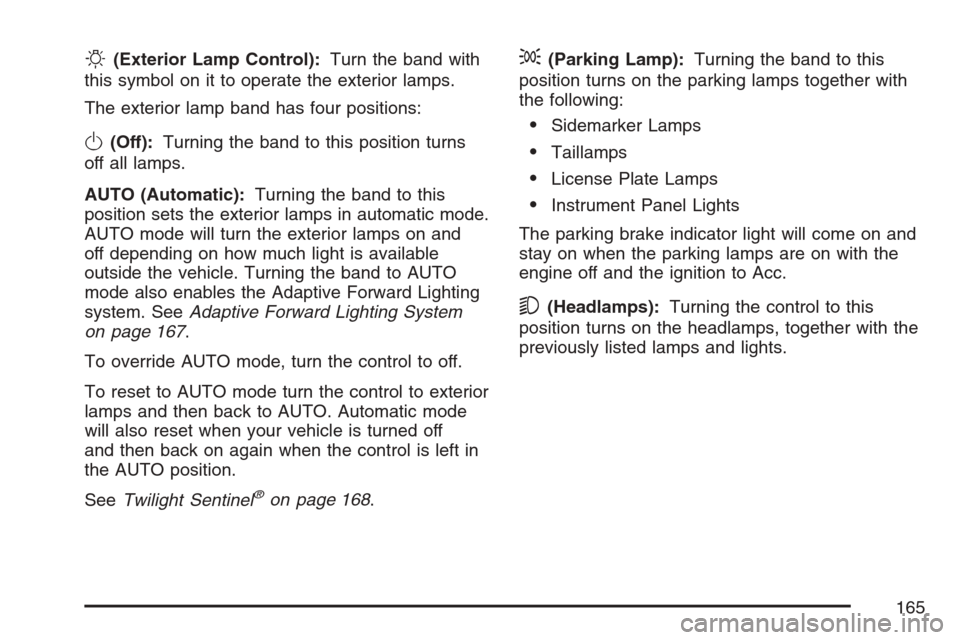
O(Exterior Lamp Control):Turn the band with
this symbol on it to operate the exterior lamps.
The exterior lamp band has four positions:
O(Off):Turning the band to this position turns
off all lamps.
AUTO (Automatic):Turning the band to this
position sets the exterior lamps in automatic mode.
AUTO mode will turn the exterior lamps on and
off depending on how much light is available
outside the vehicle. Turning the band to AUTO
mode also enables the Adaptive Forward Lighting
system. SeeAdaptive Forward Lighting System
on page 167.
To override AUTO mode, turn the control to off.
To reset to AUTO mode turn the control to exterior
lamps and then back to AUTO. Automatic mode
will also reset when your vehicle is turned off
and then back on again when the control is left in
the AUTO position.
SeeTwilight Sentinel
®on page 168.
;(Parking Lamp):Turning the band to this
position turns on the parking lamps together with
the following:
Sidemarker Lamps
Taillamps
License Plate Lamps
Instrument Panel Lights
The parking brake indicator light will come on and
stay on when the parking lamps are on with the
engine off and the ignition to Acc.
5(Headlamps):Turning the control to this
position turns on the headlamps, together with the
previously listed lamps and lights.
165
Page 166 of 512
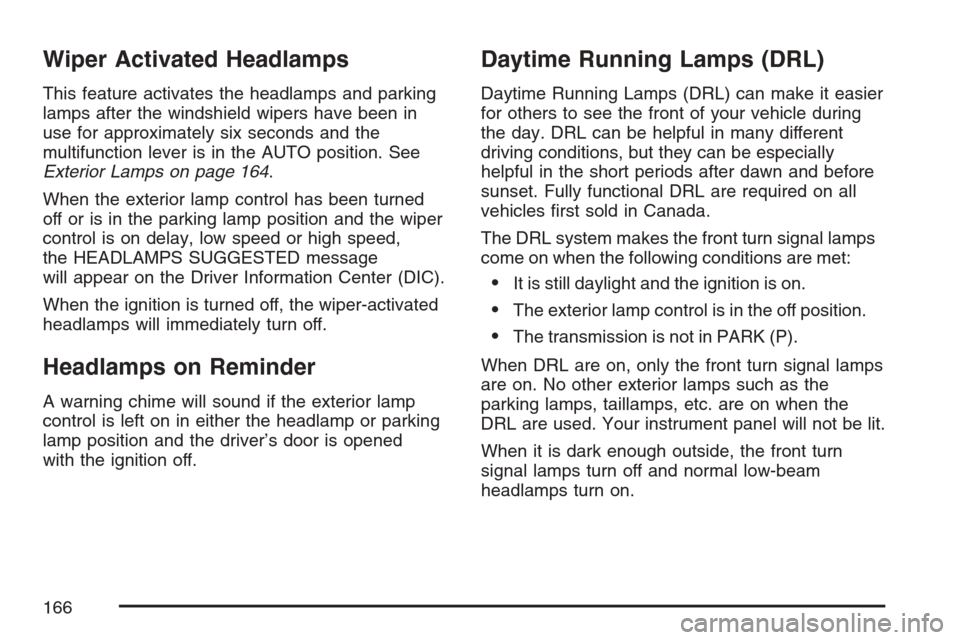
Wiper Activated Headlamps
This feature activates the headlamps and parking
lamps after the windshield wipers have been in
use for approximately six seconds and the
multifunction lever is in the AUTO position. See
Exterior Lamps on page 164.
When the exterior lamp control has been turned
off or is in the parking lamp position and the wiper
control is on delay, low speed or high speed,
the HEADLAMPS SUGGESTED message
will appear on the Driver Information Center (DIC).
When the ignition is turned off, the wiper-activated
headlamps will immediately turn off.
Headlamps on Reminder
A warning chime will sound if the exterior lamp
control is left on in either the headlamp or parking
lamp position and the driver’s door is opened
with the ignition off.
Daytime Running Lamps (DRL)
Daytime Running Lamps (DRL) can make it easier
for others to see the front of your vehicle during
the day. DRL can be helpful in many different
driving conditions, but they can be especially
helpful in the short periods after dawn and before
sunset. Fully functional DRL are required on all
vehicles �rst sold in Canada.
The DRL system makes the front turn signal lamps
come on when the following conditions are met:
It is still daylight and the ignition is on.
The exterior lamp control is in the off position.
The transmission is not in PARK (P).
When DRL are on, only the front turn signal lamps
are on. No other exterior lamps such as the
parking lamps, taillamps, etc. are on when the
DRL are used. Your instrument panel will not be lit.
When it is dark enough outside, the front turn
signal lamps turn off and normal low-beam
headlamps turn on.
166
Page 168 of 512
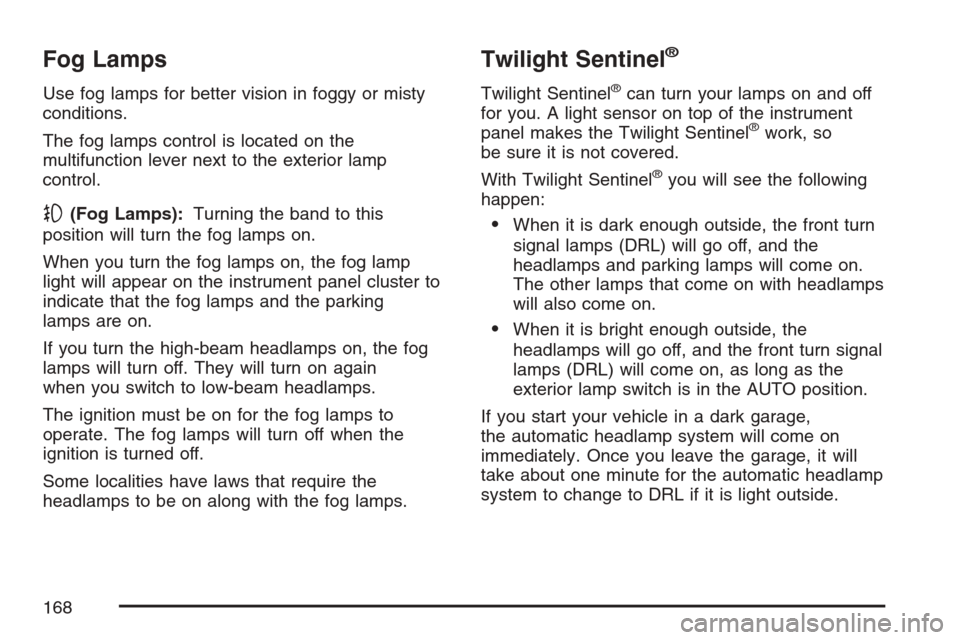
Fog Lamps
Use fog lamps for better vision in foggy or misty
conditions.
The fog lamps control is located on the
multifunction lever next to the exterior lamp
control.
-(Fog Lamps):Turning the band to this
position will turn the fog lamps on.
When you turn the fog lamps on, the fog lamp
light will appear on the instrument panel cluster to
indicate that the fog lamps and the parking
lamps are on.
If you turn the high-beam headlamps on, the fog
lamps will turn off. They will turn on again
when you switch to low-beam headlamps.
The ignition must be on for the fog lamps to
operate. The fog lamps will turn off when the
ignition is turned off.
Some localities have laws that require the
headlamps to be on along with the fog lamps.
Twilight Sentinel®
Twilight Sentinel®can turn your lamps on and off
for you. A light sensor on top of the instrument
panel makes the Twilight Sentinel
®work, so
be sure it is not covered.
With Twilight Sentinel
®you will see the following
happen:
When it is dark enough outside, the front turn
signal lamps (DRL) will go off, and the
headlamps and parking lamps will come on.
The other lamps that come on with headlamps
will also come on.
When it is bright enough outside, the
headlamps will go off, and the front turn signal
lamps (DRL) will come on, as long as the
exterior lamp switch is in the AUTO position.
If you start your vehicle in a dark garage,
the automatic headlamp system will come on
immediately. Once you leave the garage, it will
take about one minute for the automatic headlamp
system to change to DRL if it is light outside.
168
Page 169 of 512

During that delay, your instrument panel cluster
may not be as bright as usual. Make sure
your instrument panel brightness control is in full
bright position. SeeInstrument Panel Brightness
on page 170for more information.
You can idle the vehicle with the lamps off, even
when it is dark outside. After starting the
vehicle, turn the exterior lamp control band to off,
then release it. The lamps will remain off until
you turn the control band to off again.
Twilight Sentinel
®also provides exterior
illumination as you leave the vehicle. If Twilight
Sentinel
®has turned on the lamps when you turn
off the ignition, your lamps will remain on until:
The exterior lamp switch is moved from OFF to
the parking lamp position, or
a delay time that you select has elapsed.
SeeDriver Information Center (DIC) on page 203
to select the delay time that you want. You
can also select no delay time.If you turn off the ignition with the exterior lamp
switch in the parking lamp or headlamp position, the
Twilight Sentinel
®delay will not occur. The lamps
will turn off as soon as the switch is turned off.
As with any vehicle, you should turn on the regular
headlamp system when you need it.
Exterior Lighting Battery Saver
If the manual parking lamps or headlamps have
been left on, the exterior lamps will turn off as soon
as the ignition is turned off or RAP is active.
This protects against draining the battery in case
you have accidentally left the headlamps or
parking lamps on. The battery saver does not work
if the headlamps are turned on after the ignition
switch is turned to off.
If you need to leave the lamps on, use the exterior
lamp control to turn the lamps back on.
169
Page 171 of 512

Reading Lamps
Your inside rearview mirror includes two reading
lamps. The lamps will go on when a door is
opened. When the doors are closed, each lamp
can be turned on individually by pressing the
button for that lamp.
Battery Run-Down Protection
Your vehicle has a feature to help prevent the
battery from being drained, in case the underhood
lamp, vanity mirror lamps, cargo lamps, reading
lamps, console, or glove box lamps are
accidentally left on, or something is left plugged
into the accessory power outlet or cigarette lighter.
If any of the accessory lamps are left on, they
will automatically time-out after about 20 minutes.
To reset the battery protection, all of the above
lamps must be turned off or the ignition must be in
the Acc position.
Head-Up Display (HUD)
{CAUTION:
If the HUD image is too bright, or too high
in your �eld of view, it may take you more
time to see things you need to see when it
is dark outside. Be sure to keep the HUD
image dim and placed low in your �eld
of view.
The Head-Up Display (HUD) allows you to see
some of the driver information that appears
on your instrument panel cluster.
The information may be displayed in English or
metric units and appears as an image focused out
toward the front of your vehicle. To change
from English to metric units, seeDriver Information
Center (DIC) on page 203.
171
Page 174 of 512
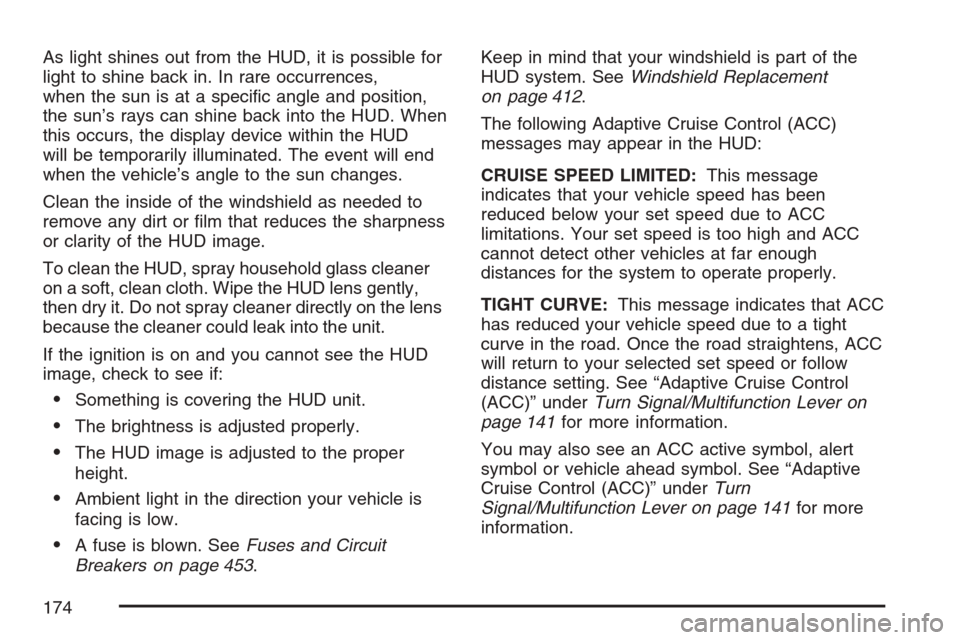
As light shines out from the HUD, it is possible for
light to shine back in. In rare occurrences,
when the sun is at a speci�c angle and position,
the sun’s rays can shine back into the HUD. When
this occurs, the display device within the HUD
will be temporarily illuminated. The event will end
when the vehicle’s angle to the sun changes.
Clean the inside of the windshield as needed to
remove any dirt or �lm that reduces the sharpness
or clarity of the HUD image.
To clean the HUD, spray household glass cleaner
on a soft, clean cloth. Wipe the HUD lens gently,
then dry it. Do not spray cleaner directly on the lens
because the cleaner could leak into the unit.
If the ignition is on and you cannot see the HUD
image, check to see if:
Something is covering the HUD unit.
The brightness is adjusted properly.
The HUD image is adjusted to the proper
height.
Ambient light in the direction your vehicle is
facing is low.
A fuse is blown. SeeFuses and Circuit
Breakers on page 453.Keep in mind that your windshield is part of the
HUD system. SeeWindshield Replacement
on page 412.
The following Adaptive Cruise Control (ACC)
messages may appear in the HUD:
CRUISE SPEED LIMITED:This message
indicates that your vehicle speed has been
reduced below your set speed due to ACC
limitations. Your set speed is too high and ACC
cannot detect other vehicles at far enough
distances for the system to operate properly.
TIGHT CURVE:This message indicates that ACC
has reduced your vehicle speed due to a tight
curve in the road. Once the road straightens, ACC
will return to your selected set speed or follow
distance setting. See “Adaptive Cruise Control
(ACC)” underTurn Signal/Multifunction Lever on
page 141for more information.
You may also see an ACC active symbol, alert
symbol or vehicle ahead symbol. See “Adaptive
Cruise Control (ACC)” underTurn
Signal/Multifunction Lever on page 141for more
information.
174